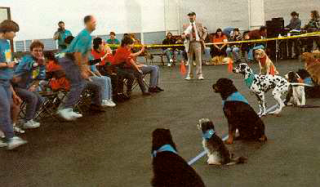Ultra Super Sit

Four Steps to an Emergency Distance Sit With a little practice you can develop and absolutely rock-solid, long-distance, sit-stay that can save you from most dangerous or embarrassing situations your dog could get into. The secret to off-leash control is to thoroughly integrate fun training into all of your dog's off-leash activities. Total integration of training and play should be your aim from the very start. Interrupt your dog's off-leash activities every minute or so. Every time you interrupt an enjoyable activity by instructing your dog to sit, for example, and then allow him to resume the activity, you are reinforcing the dog's prompt sit with a powerful reward. The more you interrupt your dog's play, the more you may reward him for sitting promptly.
First practice the following exercises in safe, enclosed areas. This can be when your puppy is off-leash in your house or yard, when he is playing in puppy classes, during puppy parties, or when off-leash in dog parks.
1. Every minute or so, run up to your puppy and take him by the collar. Praise the pup, offer a tasty food treat, and then tell him to go play again. At first try this in a fairly small area, such as your kitchen with no other distractions. Then try it with just one other puppy present. If you have difficulty catching your pup, have the other owner grab hers at the same time. Then try with a couple of other puppies present. Gradually increase the number of puppies and size of the area until your puppy is easy to catch when playing, for example, in your fenced yard. Use freeze-dried liver treats during this first exercise so your pup quickly comes to love having his collar grabbed.
2. Once your puppy is easy to catch, dry kibble will suffice. Now, instruct your puppy to sit each time after you take him by the collar. Use the food to lure the puppy into a sitting position, praise the pup as soon as he sits, offer the piece of kibble as reward, and then tell him to go play.
3. By now your puppy should feel completely at ease with your running up to reach for his collar. In fact, he probably looks forward to it, knowing he will receive a food reward before resuming play. You may find your puppy sits in anticipation of the food reward. This is good, because the next step is to instruct your puppy to sit before you reach for his collar. Run up to your puppy and waggle a piece of kibble under his nose, and once the puppy homes in on the food, use it as a lure to entice him to sit. Praise your puppy as soon as he sits, offer the kibble as a reward, and tell the puppy to go play. It is vital that you do not touch the puppy before he sits. Some owners are impatient and physically sit the dog down. If you have to rely on physical contact to get your dog to sit, you'll never have reliable off-leash distance control. If you are experiencing difficulties, go back to using freeze-dried liver.
4. Now that your puppy sits promptly as you approach, you can teach him to sit from a distance. Again try this exercise around the house without distractions before trying it with other puppies present. Sit in a chair and without moving a muscle, calmly and quietly say, "Puppy, Sit." Wait a second, then rush toward the puppy saying, "Sit! Sit! Sit!" in an urgent tone but without shouting. Praise your puppy the moment he sits, take him by the collar and let him sniff the kibble. Then quickly take one step backwards, and instruct your puppy to “Come” and “Sit.” If your puppy sits promptly, offer the piece of kibble as reward and then let him resume playing. As you repeat this over and over again, you'll discover that fewer and fewer repetitions of the instruction to sit are necessary before your puppy complies. Also, with repeated trials your puppy sits sooner and sooner and with you farther and farther away. Eventually your dog will sit promptly at a distance following a single softly spoken request.
From now on, whenever your dog is off-leash, repeatedly and frequently interrupt his activity with numerous short training interludes. Ninety percent of the training interludes should be as short as one second. Tell your dog to sit and then immediately say, "Go play." Your dog's quick sit is proof that you have control, so you needn't push it. You needn't prolong the sit stay. Instead, quickly tell your dog to go play so as to reinforce the quick sit. In one out of ten training interludes practice something a little different. Once your dog sits, instruct him to sit-stay or to down-stay. Or walk up to your dog and take him by the collar before telling him to resume playing.